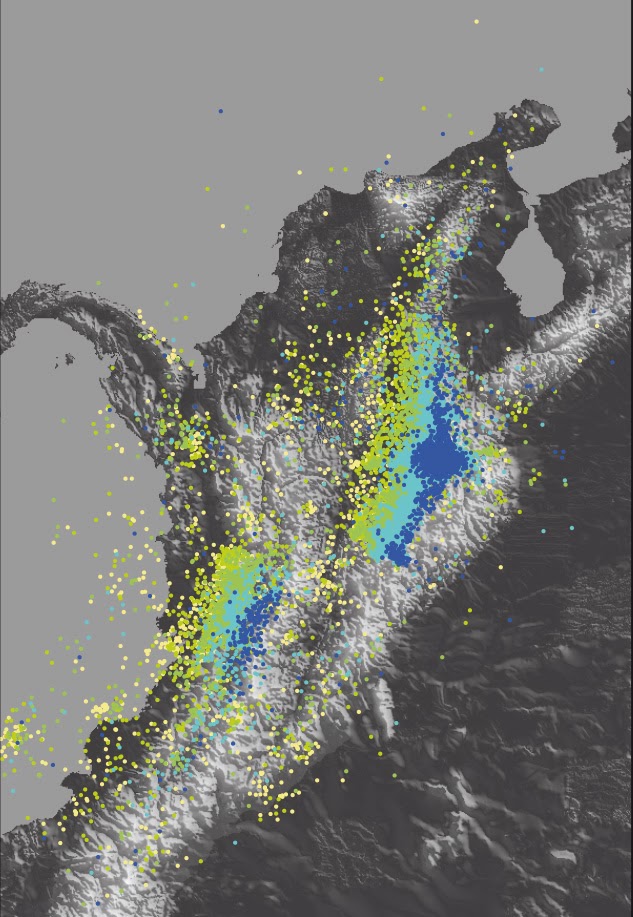
Nearly 25 percent of earthquakes occur more than 50 kilometers below the Earth’s surface, when one tectonic plate slides below another, in a region called the lithosphere. Scientists have thought that these rumblings from the deep arise from a different process than shallower, more destructive quakes. But limited seismic data, and difficulty in reproducing these quakes in the laboratory, have combined to prevent researchers from pinpointing the cause of intermediate and deep earthquakes.
Now a team from MIT and Stanford University has identified a mechanism that helps these deeper quakes spread. By analyzing seismic data from a region in Colombia with a high concentration of intermediate-depth earthquakes, the researchers identified a “runaway process” in which the sliding of rocks at great depths causes surrounding temperatures to spike. This influx of heat, in turn, encourages more sliding—a feedback mechanism that propagates through the lithosphere, generating an earthquake.
German Prieto, an assistant professor of geophysics in MIT’s Department of Earth, Atmospheric and Planetary Sciences, says that once thermal runaway starts, the surrounding rocks can heat up and slide more easily, raising the temperature very quickly.
“What we predict is for medium-sized earthquakes, with magnitude 4 to 5, temperature can rise up to 1,000 degrees Centigrade, or about 1,800 degrees Fahrenheit, in a matter of one second,” Prieto says. “It’s a huge amount. You’re basically allowing rupture to run away because of this large temperature increase.”
Prieto says that understanding deeper earthquakes may help local communities anticipate how much shaking they may experience, given the seismic history of their regions.
He and his colleagues have published their results in the journal Geophysical Research Letters.
Water versus heat: two competing theories
The majority of Earth’s seismic activity occurs at relatively shallow depths, and the mechanics of such quakes is well understood: Over time, abutting plates in the crust build up tension as they shift against each other. This tension ultimately reaches a breaking point, creating a sudden rupture that splinters through the crust.
However, scientists have determined that this process is not feasible for quakes that occur far below the surface. Essentially, higher temperatures and pressures at these depths would make rocks behave differently than they would closer to the surface, gliding past rather than breaking against each other.
By way of explanation, Prieto draws an analogy to glass: If you try to bend a glass tube at room temperature, with enough force, it will eventually shatter. But with heating, the tube will become much more malleable, and bend without breaking.
So how do deeper earthquakes occur? Scientists have proposed two theories: The first, called dehydration embrittlement, is based on the small amounts of water in rocks’ mineral composition. At high pressure and heat, rocks release water, which lubricates surrounding faults, creating fractures that ultimately set off a quake.
The second theory is thermal runaway: Increasing temperatures weaken rocks, promoting slippage that spreads through the lithosphere, further increasing temperatures and causing more rocks to slip, resulting in an earthquake.
Probing the nest
Prieto and his colleagues found new evidence in support of the second theory by analyzing seismic data from a region of Colombia that experiences large numbers of intermediate-depth earthquakes—quakes whose epicenters are 50 to 300 kilometers below the surface. This region, known as the Bucaramanga Nest, hosts the highest concentration of intermediate-depth quakes in the world: Since 1993, more than 80,000 earthquakes have been recorded in the area, making it, in Prieto’s view, an “ideal natural laboratory” for studying deeper quakes.
The researchers analyzed seismic waves recorded by nearby surface seismometers and calculated two parameters: stress drop, or the total amount of energy released by an earthquake, and radiated seismic energy, or the amount of that energy that makes it to the surface as seismic waves—energy that is manifested in the shaking of the ground.
The stronger a quake is, the more energy, or heat, it generates. Interestingly, the MIT group found that only 2 percent of a deeper quake’s total energy is felt at the surface. Prieto reasoned that much of the other 98 percent may be released locally as heat, creating an enormous temperature increase that pushes a quake to spread.
Prieto says the study provides strong evidence for thermal runaway as the likely mechanism for intermediate-depth earthquakes. Such knowledge, he says, may be useful for communities around Bucaramanga in predicting the severity of future quakes.
“Usually people in Bucaramanga feel a magnitude 4 quake every month or so, and every year they experience a larger one that can shake significantly,” Prieto says. “If you’re in a region where you have intermediate-depth quakes and you know the size of the region, you can make a prediction of the type of magnitudes of quakes that you can have, and what kind of shaking you would expect.”
Prieto, a native Colombian, plans to deploy seismic stations above the Bucaramanga Nest to better understand the activity of deeper quakes.
Note : The above story is based on materials provided by Massachusetts Institute of Technology










